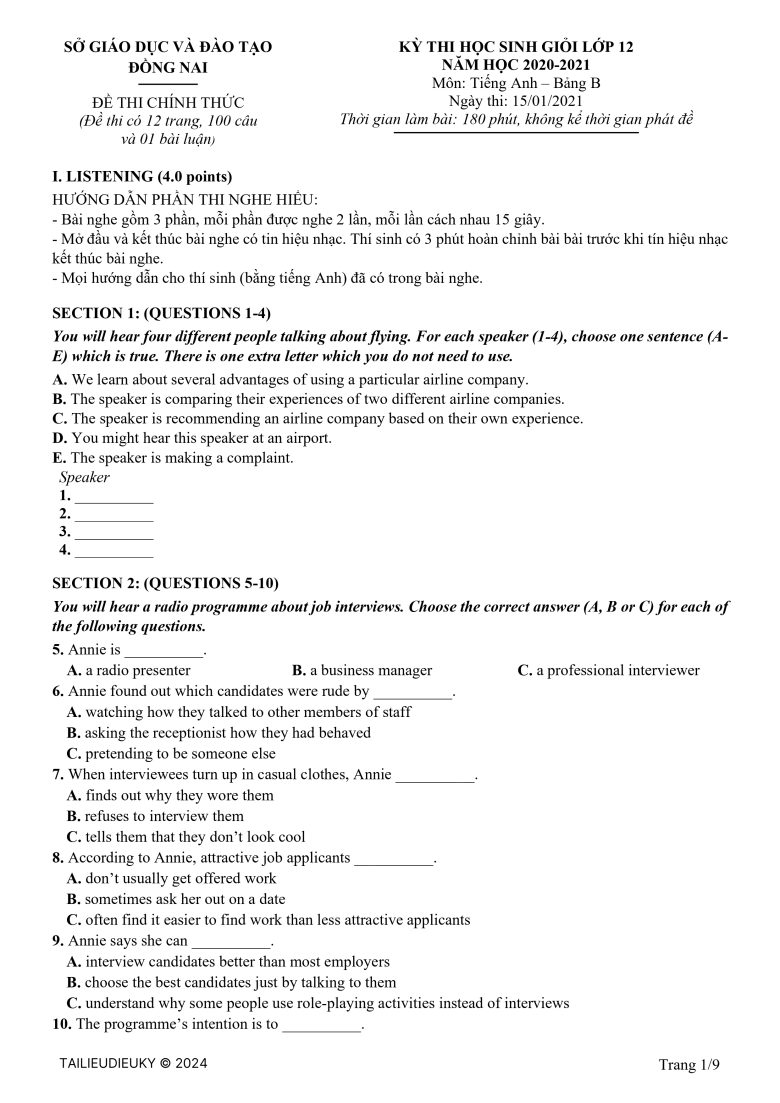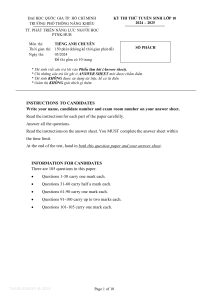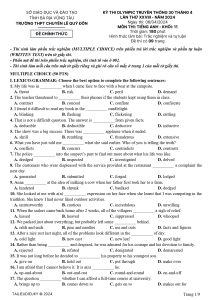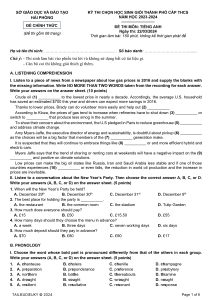Đề thi HSG Tiếng Anh 12 tỉnh Đồng Nai năm học 2020-2021 bảng B (không chuyên) có đáp án đã được cập nhật tại website Tài liệu diệu kỳ. Bài thi nằm trong Kỳ thi học sinh giỏi lớp 12 THPT năm học 2020-2021 diễn ra vào 15/01/2021 thu hút gần 3000 thí sinh của 67 trường phổ thông, trung tâm giáo dục thường xuyên thuộc Sở GD&ĐT Đồng Nai. Đề thi chính thức môn Tiếng Anh có 12 trang gồm 100 câu và 1 bài luận. Thí sinh hoàn thành bài trong 180 phút không kể thời gian phát đề.
Kỳ thi học sinh giỏi lớp 12 cấp tỉnh Đồng Nai năm học 2020-2021 có 9 môn thi gồm: Toán, Lý, Hóa, Sinh, Ngữ văn, Sử, Địa, Tin học và Tiếng Anh diễn ra tại 3 điểm thi: THPT chuyên Lương Thế Vinh, THPT Trấn Biên và TH-THCS-THPT Đinh Tiên Hoàng (TP. Biên Hòa).
Kết quả chính thức sẽ được công bố ngay khi Hội đồng chấm thi hoàn thành chấm thi và xếp giải. Những thí sinh có thành tích xuất sắc ở các môn thi trong kỳ thi học sinh giỏi khối 12 cấp tỉnh sẽ được Sở GD&ĐT lựa chọn bồi dưỡng để tiếp tục tham gia Kỳ thi học sinh giỏi Quốc gia THPT năm 2021.
Về cơ bản, format đề thi HSG Tiếng Anh 12 tại tỉnh Đồng Nai có cấu trúc tương tự các năm trước gồm 100 câu hỏi và 01 bài luận, tổng điểm toàn bài được quy đổi về 20.
I. Listening (4.0 points) - 20 questions
The listening test comprises three sections: speakers discussing airline terms, a job interview program, and a museum director describing exhibits. Test-takers must listen attentively and select the correct answers for each part.
II. Phonology (1.0 point) - 10 questions
The Phonology section assesses pronunciation and stress placement. Questions 21-25 focus on distinguishing words by sound, while 26-30 target identifying words with varying primary stress positions.
III. Lexico-Grammar (2.0 points) - 20 questions
The Lexico-Grammar section assesses sentence structure and word usage. Questions 31-45 require selecting correct grammar usage, while 46-50 involve completing sentences with appropriate word forms
IV. Proof-reading (2.0 points) - 10 questions
The Proofreading section evaluates grammatical accuracy. Errors include subject-verb agreement, article usage, pronoun consistency, and word choice.
V. Reading comprehension (4.0 points) - 20 questions
The Reading Comprehension section discusses mound-builder theories and ecotourism. It highlights misconceptions about Native American cultures and the commercialization of eco-friendly travel.
VI. Guided cloze test (2.0 points) - 10 questions
The Guided Cloze Test assesses vocabulary and context. Candidates select appropriate words to complete the passage.
VII. Guided cloze test (5.0 points) - 10 questions and one essay
In the Writing section, candidates complete sentence transformations and write an essay expressing their opinion on technology's role in education.
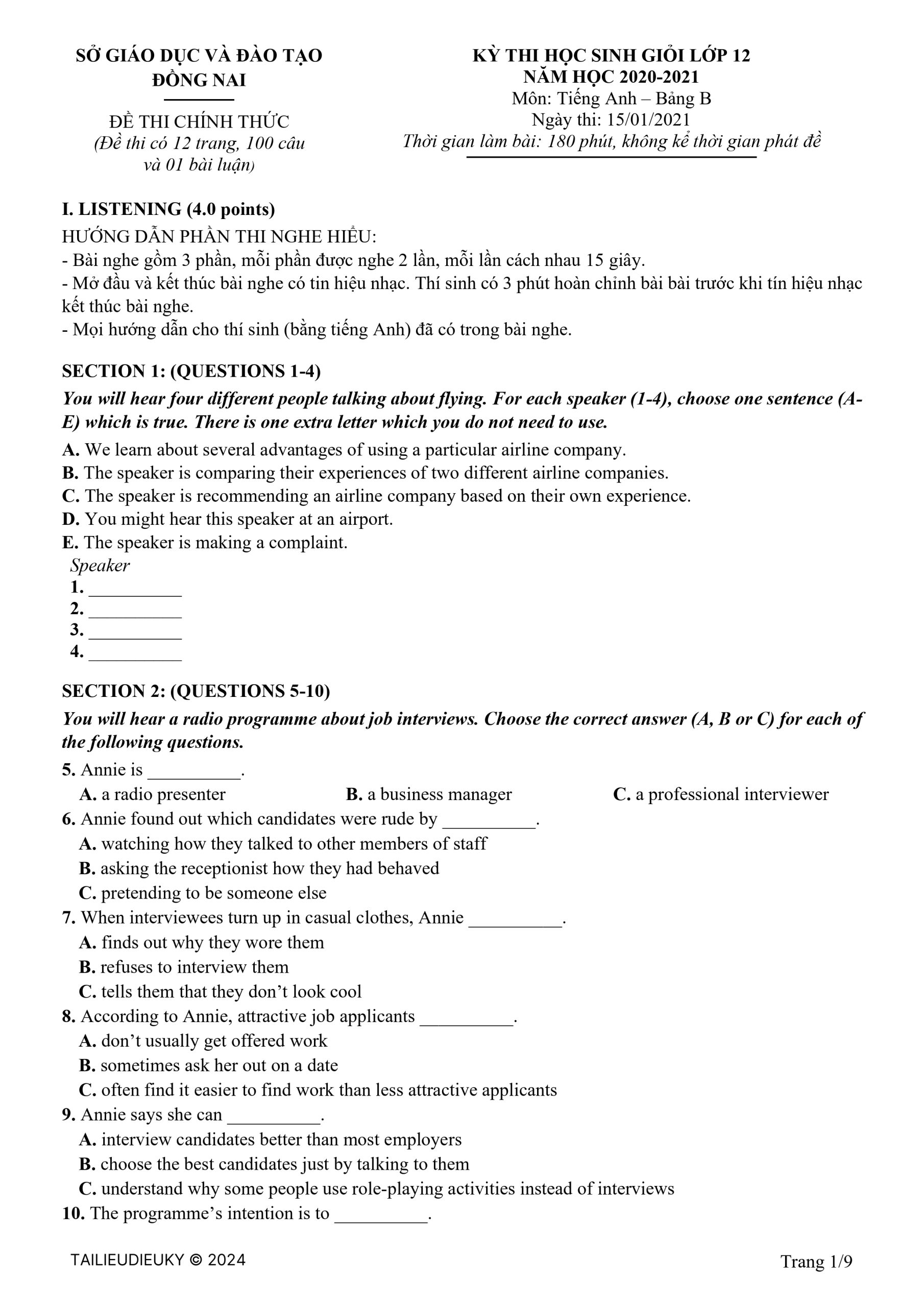
Đề thi HSG Tiếng Anh 12 tỉnh Đồng Nai năm học 2020-2021 bảng B (không chuyên) - Trang 1
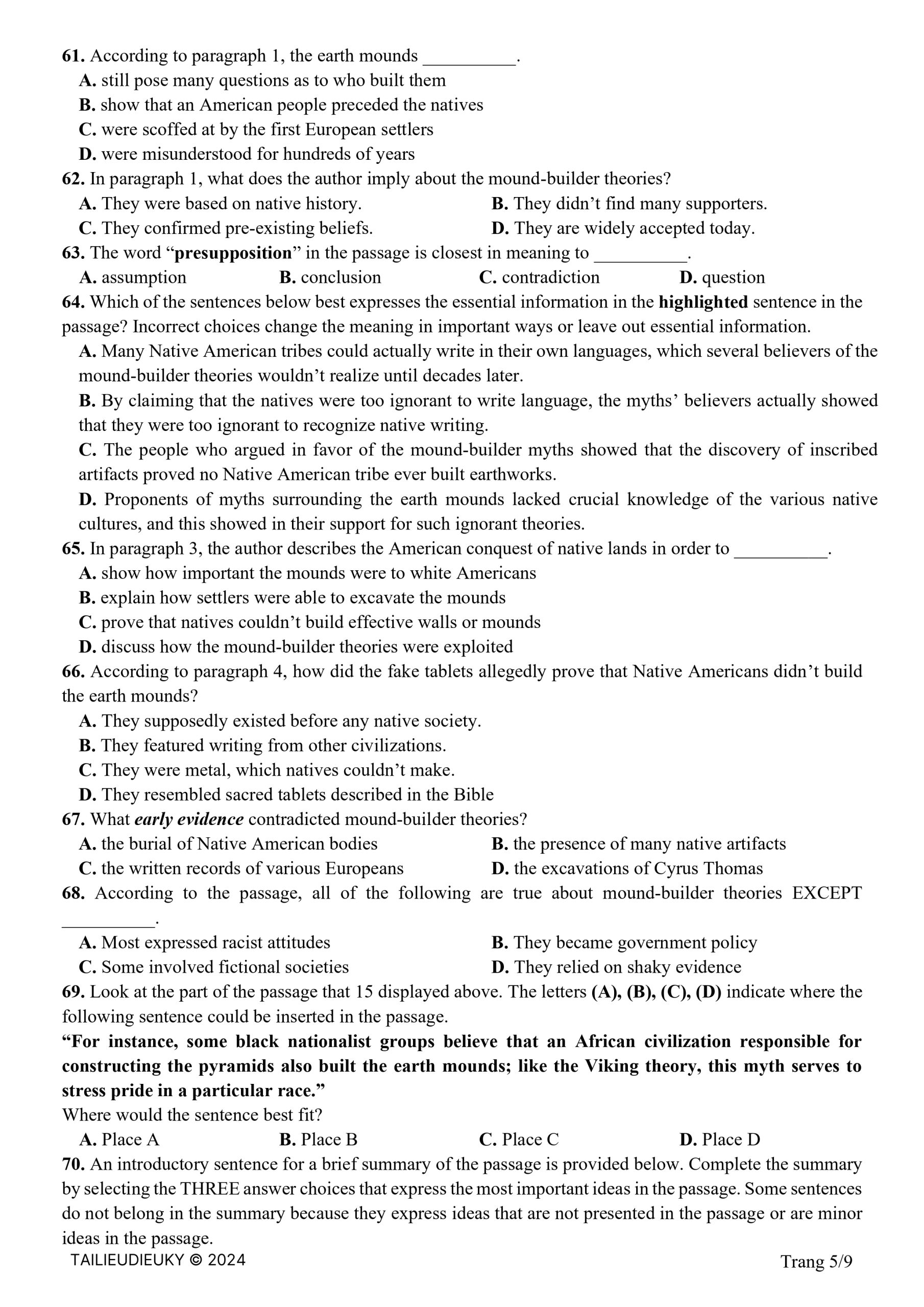
Đề thi HSG Tiếng Anh 12 tỉnh Đồng Nai năm học 2020-2021 bảng B (không chuyên) - Trang 5
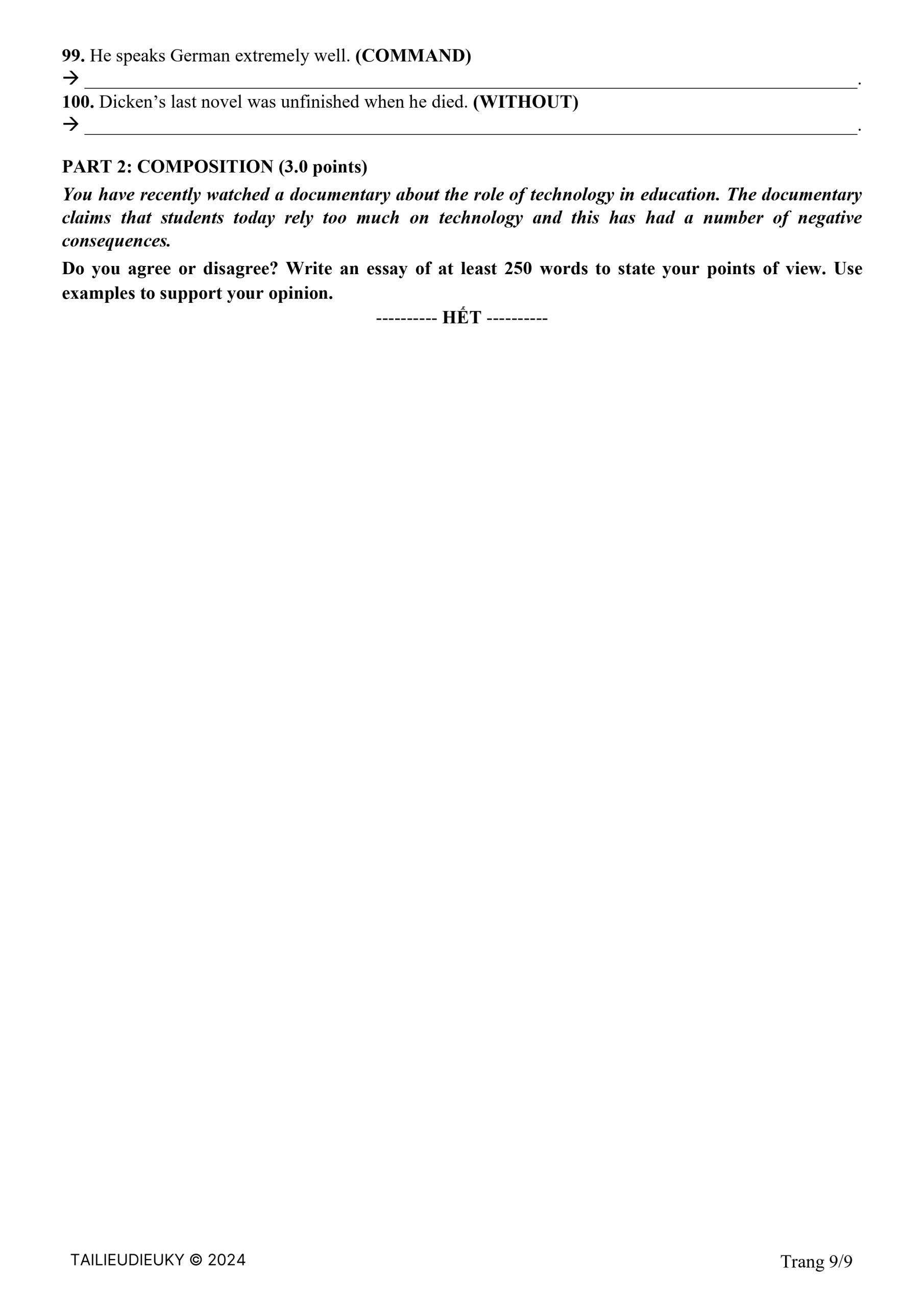
Đề thi HSG Tiếng Anh 12 tỉnh Đồng Nai năm học 2020-2021 bảng B (không chuyên) - Trang 9
Đáp án chính thức Đề thi HSG Tiếng Anh 12 tỉnh Đồng Nai năm học 2020-2021 bảng B (không chuyên):
SỞ GIÁO DỤC VÀ ĐÀO TẠO
ĐỒNG NAI
ĐÁP ÁN CHÍNH THỨC
(Đáp án có 03 trang)
KỲ THI HỌC SINH GIỎI LỚP 12
NĂM HỌC 2020-2021
Môn: Tiếng Anh – Bảng B
Ngày thi: 15/01/2021
Thời gian làm bài: 180 phút, không kể thời gian phát đề
I. LISTENING (4.0 pts)
Section 1. 1 C
2 E
3 A
4 D
Section 2. 5 B
6 C
7 A
8 C
9 B
10 C
Section 3. 11 1973/ nineteen seventy-three
12 lighting/lights
13 four two nights/four hundred and twenty-nine/429
14 age
15 leaf
16 (two) cows
17 eyes
18 monster
19 detailed
20 fish
II. PHONOLOGY (1 pt)
21-25 21 A
22 B
23 A
24 A
25 D
26-30 26 D
27 B
28 B
29 D
30 C
III. LEXICO-GRAMMAR (2 pts)
31-45 31 D
32 C
33 A
34 B
35 C
36 D
37 C
38 B
39 A
40 A
41 C
42 C
43 B
44 B
45 D
46-50 46 deforestation
47 knowledgeable
48 theoretically
49 circumstantial
50 confidential
IV. PROOF-READING (2.0 pts)
51-60 51 Line 3: telling => told
52 Line 5: its => their
53 Line 6: A => This
54 Line 8: in => of
55 Line 11: advertisers => audiences/viewers
56 Line 12: at => to
57 Line 15: after => before
58 Line 19: commercials => product
59 Line 23: intention => attention
60 Line 24: interesting => interested
V. READING COMPREHENSION (4.0 pts)
61-70 61 D
62 C
63 A
64 B
65 D
66 B
67 C
68 B
69 B
70 A, B, E
71-80 71 Yes
72 Yes
73 Not given
74 No
75 Not given
76 B, D, E
77
78
79 A, D
80
VI. GUIDED CLOZE TEST (2.0 pts)
81-90 81 A
82 D
83 D
84 A
85 B
86 A
87 A
88 C
89 B
90 C
VII. WRITING (5.0 pts)
Part 1. 91 No beaches in the world are said to be as beautiful as those in Hawaii.
92 Were they to offer you the scholarship, would you accept it?
93 Ever since (he had) his accident, Phillip has been unable/has not been able to make decisions.
94 I always take transport costs into consideration/account when travelling.
I always take account of transport costs when travelling.
95 No sooner had he arrived than things went wrong.
96 His behavior took me aback.
I was taken aback by his behavior.
97 In the area, Thailand is head and shoulders above all other countries in football.
98 The disagreement is a storm in a teacup.
99 He has (a) good command of (spoken) German.
100 Dicken died without finishing/having finished his last novel.
Part 2. Essay writing (3.0 pts)
- Well-organized with transitions. (0.75 pt)
- Contains some varied sentence structures and exhibits specific word choice. (0.75 pt)
- Contains little or no errors in grammar; errors do not interfere with understanding. (0.75 pt)
- Clearly states the position and effectively persuades the readers of validity of argument. (0.75 pt)
Trích dẫn nội dung Đề thi HSG Tiếng Anh 12 Đồng Nai, năm học 2020-2021:
SỞ GIÁO DỤC VÀ ĐÀO TẠO
ĐỒNG NAI
ĐỀ THI CHÍNH THỨC
(Đề thi có 12 trang, 100 câu
và 01 bài luận)
KỲ THI HỌC SINH GIỎI LỚP 12
NĂM HỌC 2020-2021
Môn: Tiếng Anh – Bảng B
Ngày thi: 15/01/2021
Thời gian làm bài: 180 phút, không kể thời gian phát đề
I. LISTENING (4.0 points)
HƯỚNG DẪN PHẦN THI NGHE HIỂU: - Bài nghe gồm 3 phần, mỗi phần được nghe 2 lần, mỗi lần cách nhau 15 giây.
- Mở đầu và kết thúc bài nghe có tin hiệu nhạc. Thí sinh có 3 phút hoàn chỉnh bài bài trước khi tín hiệu nhạc kết thúc bài nghe.
- Mọi hướng dẫn cho thí sinh (bằng tiếng Anh) đã có trong bài nghe.
SECTION 1: (QUESTIONS 1-4)
You will hear four different people talking about flying. For each speaker (1-4), choose one sentence (A-E) which is true. There is one extra letter which you do not need to use.
A. We learn about several advantages of using a particular airline company.
B. The speaker is comparing their experiences of two different airline companies.
C. The speaker is recommending an airline company based on their own experience.
D. You might hear this speaker at an airport.
E. The speaker is making a complaint.
Speaker
1. __________
2. __________
3. __________
4. __________
SECTION 2: (QUESTIONS 5-10)
You will hear a radio programme about job interviews. Choose the correct answer (A, B or C) for each of the following questions.
5. Annie is __________.
A. a radio presenter B. a business manager C. a professional interviewer
6. Annie found out which candidates were rude by __________.
A. watching how they talked to other members of staff
B. asking the receptionist how they had behaved
C. pretending to be someone else
7. When interviewees turn up in casual clothes, Annie __________.
A. finds out why they wore them
B. refuses to interview them
C. tells them that they don’t look cool
8. According to Annie, attractive job applicants __________.
A. don’t usually get offered work
B. sometimes ask her out on a date
C. often find it easier to find work than less attractive applicants
9. Annie says she can __________.
A. interview candidates better than most employers
B. choose the best candidates just by talking to them
C. understand why some people use role-playing activities instead of interviews
10. The programme’s intention is to __________.
A. inform people of successful interview techniques
B. criticise the amount of interview training young people get
C. entertain listeners with amusing real experiences
SECTION 3: (QUESTIONS 11-20)
You will hear a museum director called Cari Halford talking about the museum where he works. For questions 11-20, fill in each blank with a suitable word or phrase. Write NO MORE THAN FOUR WORDS OR/AND A NUMBER for each answer.
Museum director
Carl says that the museum was last renovated in the year 11. __________.
Carl says that improvements in the 12. __________ in museums often goes unnoticed.
There are now a total of 13. __________ exhibits which visitors can see in the museum.
The exhibits are now arranged according to their 14. __________.
One of Carl’s favorite pieces is a 4,500-year-old cup with a design of a 15. __________ on the bottom.
Carl describes a strange farm model in the museum that features 16. __________ and a farmer.
Some visitors to the museum are frightened by the 17. __________ of one large statue.
Carl also describes a vase which shows a man fighting with a 18. __________.
Carl finds it surprising that one of the coins in the museum has such 19. __________ decoration.
One simple exhibit that Carl likes is a plain stone with a picture of a 20. __________ on it.
II. PHONOLOGY (QUESTIONS 21-30) (1.0 point)
QUESTIONS 21-25: Choose the word whose underlined part differs from the other three in pronunciation in each of the following questions.
21. A. ecosystem B. knowledge C. technology D. commodity
22. A. crooked B. watched C. wretched D. sacred
23. A. southern B. plough C. round D. couch
24. A. executive B. execrable C. exhale D. exhibition
25. A. measure B. division C. precision D. apprehension
QUESTIONS 26-30: Choose the word that differs from the other three in the position of primary stress in each of the following questions.
26. A. infamous B. ignorant C. negligence D. essential
27. A. sustainable B. perseverance C. replenishment D. anonymous
28. A. agricultural B. environmental C. biological D. geographical
29. A. tuberculosis B. mathematician C. communication D. immediately
30. A. architectural B. cosmopolitan C. appreciative D. archaeologist
II LEXICO-GRAMMAR (QUESTIONS 31-50) (2.0 points)
QUESTIONS 31-45: Choose the correct answer to each of the following sentences.
31. “Which is more important: luck or effort?” - “Luck is __________ effort.”
A. of the same importance B. the same importance
C. as the same importance as D. of the same importance as
32. “Do you like frog legs?” - “__________ them, I don’t really know.”
A. Never try B. Not to have tried C. Never having tried D. Never had tried
33. Nick __________ passwords, but using IE instead of Firefox cured the problem!
A. was forever losing B. was always lost C. is losing D. constantly lost
34. John __________ the key. I cannot see it anywhere.
A. needn’t have taken B. must have taken C. should have taken D. could have taken
35. This is __________ the most difficult job I’ve ever had to do.
A. by heart B. by chance C. by far D. by myself
36. Don’t tell anyone about this, __________?
A. do you B. should you C. won’t you D. will you
37. His advisor recommended that he __________ at least three courses each semester.
A. takes B. took C. take D. would take
38. The company was so successful during the 1990s that it __________ 500 new employees in a period of six months.
A. put on B. took on C. caught on D. laid on
39. I’m afraid we have __________ a lot of criticism over our decision to close the hospital.
A. come in for B. come down with C. come out with D. come up with
40. The restaurant is popular with film stars and the __________.
A. like B. same C. similar D. such
41. Look at Karen! The color of her skirt does not __________ the color of her hat at all.
A. fit B. fix C. match D. suit
42. I just took it as __________ that anyone who applied for the course would have the necessary qualifications.
A. fixed B. standard C. read D. word
43. It must be true. I heard it straight from the __________ mouth.
A. dog’s B. horse’s C. camel’s D. cat’s
44. I thought that Wendy’s action was rather out of __________.
A. personality B. character C. being D. role
45. Mary stayed as cool as __________ and gave not even the slightest sign that she had met him before.
A. a bell B. a pancake C. a sheet D. a cucumber
QUESTIONS 46-50: Complete the following sentences with the correct forms of the words given.
46. It is said that the problem of rapid climate change has been caused by too drastic __________. (FOREST)
47. Barbara is very __________ about birds. She knows a lot about them. (KNOWLEDGE)
48. His plan is __________ good but it won’t work in practice. (THEORY)
49. I can’t convict a man of crime on __________ evidence alone. (CIRCUMSTANCE)
50. Now don’t tell anyone else what I’ve just told you. Remember, it’s __________. (CONFIDE)
IV. PROOFREADING (QUESTIONS 51-60) (2.0 points)
For questions 51-60, there are 10 mistakes (except the example) in the following text. Sort out and correct them. You shouldn’t write out the text but you have to specify 3 things: the question number, the line number and the corrected form of each word.
Here is the example: Question 00: line 1: are => is
A TV commercial is a span of TV programming which are produced and paid for by an organization to convey a message about their product. Advertising companies say a commercial is a story telling in about 30 seconds.
Watching TV often makes people feel like they are hypnotized. This means that it is easier to affect its subconscious mind. When people watch TV, they use the right-hand side of their brain. A side of the brain responds to things emotionally and visually. It is this subconscious part of our mind which advertisers take advantage in and which affects what we buy after seeing a commercial.
There are three main factors in the way TV advertising works: the design, the motive for someone to buy a product, and the acceptance of the advertisers to be influenced by the commercial. In order for TV commercials at work, they must leave an impression in our brain within seconds, but commercials can only be effective if people are exposed to them regularly. Consumers need to see a commercial at least seven times after it can have an effect.
Advertisers create a need. Commercials often use images which make us think more about the things we like: they can show happy families, glamorous places, and beautiful people. Even if we only see the image for an average of 1.5 seconds, we will then see the commercials and associate positive things with the brand. The language of advertising is very also important: it must persuade us to buy a product. Words need to be direct, short, and active. Some examples of the most persuasive words used in advertising are: “suddenly”, “amazing”, “magic”, and “hurry”. These words catch people’s intention and make an audience interesting in a product.
V. READING COMPREHENSION (QUESTIONS 61-80) (4.0 points)
QUESTIONS 61-70: Read the following passage and choose the correct answer to each of the questions.
Mound-Builder Theories
Some of the most impressive geographical features in North America are the many earth mounds scattered around the continent. These earthworks are enormous artificial hills constructed by various Native American civilizations for ritualistic purposes, such as burials and worship, and they are thousands of years old, with the latest ones being finished hundreds of years before Europeans explored America. Upon their arrival, European explorers were impressed with the structures, but prejudice against the native tribes prevented them from accrediting Native Americans with their construction. Instead, American settlers developed several theories that claimed a superior but extinct “mound-builder” civilization made the earthworks. Moreover, particular details of different mound-builder theories reflected the specific prejudices of the people who supported them. For example, devout Christian groups like the Mormons argued that a sacred Israeli society was responsible, and white Americans argued that only the Vikings could have built such mounds because they believed that their European ancestors were far superior to Native Americans. The persistence of these myths showed how for centuries Americans selectively examined evidence and distorted science in order to support their own agendas against the natives.
Prior to the 20th century, many Americans accepted the mound-builder theories as facts, despite the dubious evidence that supported them. For instance, most believers argued that the presence of metal artifacts beneath the mounds showed that the natives couldn’t have built them because they had no knowledge of metallurgy. Some tribes did in fact possess such skills, and the presence of defensive walls around tribal lands indicates that Native Americans could indeed construct structures such as earth mounds. Nonetheless, most Americans dismissed such evidence and instead considered other potential candidates for the mound builders. Popular choices were ancient Chinese, Greek, or African civilizations, none of which were in prehistoric America. Other - people argued that mystical forces, such as God or people from mythical Atlantis, built the mounds.
A common presupposition for all of these theories was that the natives were too unskilled and primitive to build these intricate and complex structures. Ironically, by proclaiming the natives’ ignorance, these theorists often displayed their own ignorance: they didn’t recognize that the writings on many artifacts excavated from the mounds were Native American, particularly because they didn’t know that these tribes had written languages. However, the popularity of these myths wasn’t solely the result of racism and ignorance: these theories also served the Americans’ agenda of seizing native lands. During the 19th century, when these theories were most popular, Americans expanded throughout the continent and eventually gained total control of all native territory. The settlers often justified their conquests by claiming that the natives themselves had stolen the land after they eradicated the mound-builders, so the Americans were essentially avenging these vanished peoples.
In order to support these agendas, proponents of the mound-builder theories would point to any bit of evidence, no matter how weak, that lent credence to their claims, and some even planted false evidence. Throughout the 19th century, excavations at many mound sites produced forged tablets, and these supported theories that either the natives had killed the original builders of the earth mounds or that the mounds were indeed built by a sacred people. All of these were inscribed with different languages, such as Mayan, Chinese, Hebrew, and Egyptian, and this supposedly proved that non-native civilizations built these mounds. (A) While these findings were eventually. exposed as frauds, the mound-builder theories persisted, even to this day, especially among groups that claim racial superiority over the natives. (B)
Regardless of the misinformation and domineering prejudice that supported mound-builder theories, there has always been support for the idea that natives constructed the earthworks. (C) The early American president Thomas Jefferson reached this conclusion when he performed excavations at these sites and recognized similarities between native burials and mound burials. (D) Also, early evidence includes accounts by Spanish and French explorers who stayed with various native tribes and learned of the construction of many mounds. The myths finally ceased to be the dominating view after ethnologist Cyrus Thomas proved that native tribes constructed the mounds. At the end of the 19th century, this also became the United States government’s official position.
61. According to paragraph 1, the earth mounds __________.
A. still pose many questions as to who built them
B. show that an American people preceded the natives
C. were scoffed at by the first European settlers
D. were misunderstood for hundreds of years
62. In paragraph 1, what does the author imply about the mound-builder theories?
A. They were based on native history. B. They didn’t find many supporters.
C. They confirmed pre-existing beliefs. D. They are widely accepted today.
63. The word “presupposition” in the passage is closest in meaning to __________.
A. assumption B. conclusion C. contradiction D. question
64. Which of the sentences below best expresses the essential information in the highlighted sentence in the passage? Incorrect choices change the meaning in important ways or leave out essential information.
A. Many Native American tribes could actually write in their own languages, which several believers of the mound-builder theories wouldn’t realize until decades later.
B. By claiming that the natives were too ignorant to write language, the myths’ believers actually showed that they were too ignorant to recognize native writing.
C. The people who argued in favor of the mound-builder myths showed that the discovery of inscribed artifacts proved no Native American tribe ever built earthworks.
D. Proponents of myths surrounding the earth mounds lacked crucial knowledge of the various native cultures, and this showed in their support for such ignorant theories.
65. In paragraph 3, the author describes the American conquest of native lands in order to __________.
A. show how important the mounds were to white Americans
B. explain how settlers were able to excavate the mounds
C. prove that natives couldn’t build effective walls or mounds
D. discuss how the mound-builder theories were exploited
66. According to paragraph 4, how did the fake tablets allegedly prove that Native Americans didn’t build the earth mounds?
A. They supposedly existed before any native society.
B. They featured writing from other civilizations.
C. They were metal, which natives couldn’t make.
D. They resembled sacred tablets described in the Bible
67. What early evidence contradicted mound-builder theories?
A. the burial of Native American bodies B. the presence of many native artifacts
C. the written records of various Europeans D. the excavations of Cyrus Thomas
68. According to the passage, all of the following are true about mound-builder theories EXCEPT __________.
A. Most expressed racist attitudes B. They became government policy
C. Some involved fictional societies D. They relied on shaky evidence
69. Look at the part of the passage that 15 displayed above. The letters (A), (B), (C), (D) indicate where the following sentence could be inserted in the passage.
“For instance, some black nationalist groups believe that an African civilization responsible for constructing the pyramids also built the earth mounds; like the Viking theory, this myth serves to stress pride in a particular race.”
Where would the sentence best fit?
A. Place A B. Place B C. Place C D. Place D
70. An introductory sentence for a brief summary of the passage is provided below. Complete the summary by selecting the THREE answer choices that express the most important ideas in the passage. Some sentences do not belong in the summary because they express ideas that are not presented in the passage or are minor ideas in the passage.
Mound-builder theories were prevalent and popular in America throughout the 19th century.
A. People had always argued against mound-builder theories, even when they were widely - accepted.
B. Despite the lack of credible science or research, many of the outlandish theories were accepted virtually as proven fact.
C. The earth mounds were large structures that served as ritual sites for the Native Americans.
D. Americans annexed native territory as revenge for what the tribes had done to the society that constructed the earth mounds.
E. The theories reflected and reinforced popular beliefs about the natives’ inferiority to the settlers.
F. Thomas Jefferson found that many of the burial rituals at the mounds were not at all similar to Native American burials.
QUESTIONS 71-80: Read the following passage and choose the correct answer to each of the questions.
IT’S ECO-LOGICAL
Planning an eco-friendly holiday can be a minefield for the well- meaning traveller, says Steve Watkins. But help is now at hand.
If there were awards for tourism phrases that have been hijacked, diluted and misused then ‘ecotourism’ would earn top prize. The term first surfaced in the early 1980s reflecting a surge in environmental awareness and a realisation by tour operators that many travellers wanted to believe their presence abroad would not have a negative impact. It rapidly became the hottest marketing tag a holiday could carry.
These days the ecotourism label is used to cover anything from a two-week tour living with remote Indonesian tribes, to a one-hour motorboat trip through an Australian gorge. In fact, any tour that involves cultural interaction, natural beauty spots, wildlife or a dash of soft adventure is likely to be included in the overflowing ecotourism folder. There is no doubt the original motives behind the movement were honourable attempts to provide a way for those who cared to make informed choices, but the lack of regulations and a standard industry definition left many travellers lost in an ecotourism jungle.
It is easier to understand why the ecotourism market has become so overcrowded when we look at its wider role in the world economy. According to World Tourism Organisation figures, ecotourism is worth US$20 billion a year and makes up one-fifth of all international tourism. Add to this an annual growth rate of around five per cent and the pressure for many operators, both in developed and developing countries, to jump on the accelerating bandwagon is compelling. Without any widely recognised accreditation system, the consumer has been left to investigate the credentials of an operator themselves. This is a time-consuming process and many travellers usually take an operator’s claims at face value, only adding to the proliferation of fake ecotours.
However, there are several simple questions that will provide qualifying evidence of a company’s commitment to minimise its impact on the environment and maximise the benefits to the tourism area’s local community. For example, does the company use recycled or sustainable, locally harvested materials to build its tourist properties? Do they pay fair wages to all employees? Do they offer training to employees? It is common for city entrepreneurs to own tour companies in country areas, which can mean the money you pay ends up in the city rather than in the community being visited. By taking a little extra time to investigate the ecotourism options, it is not only possible to guide your custom to worthy operators but you will often find that the experience they offer is far more rewarding.
The ecotourism business is still very much in need of a shake-up and a standardised approach. There are a few organisations that have sprung up in the last ten years or so that endeavour to educate travellers and operators about the benefits of responsible ecotourism. Founded in 1990, the Ecotourism Society (TES) is a non-profit organisation of travel industry, conservation and ecological professionals, which aims to make ecotourism a genuine tool for conservation and sustainable development. Helping to create inherent economic value in wilderness environments and threatened cultures has undoubtedly been one of the ecotourism movement’s most notable achievements. TES organises an annual initiative to further aid development of the ecotourism industry. This year it is launching ‘Your Travel Choice Makes a Difference’, an educational campaign aimed at helping consumers understand the potential positive and negative impacts of their travel decisions. TES also offers guidance on the choice of ecotour and has established a register of approved ecotourism operators around the world.
A leading ecotourism operator in the United Kingdom is Tribes, which won the 1999 Tourism Concern and Independent Traveller’s World ‘Award for Most Responsible Tour Operator’. Amanda Marks, owner and director of Tribes, believes that the ecotourism industry still has some way to go to get its house in order. Until now, no ecotourism accreditation scheme has really worked, principally because there has been no systematic way of checking that accredited companies actually comply with the code of practice. Amanda believes that the most promising system is the recently re-launched Green Globe 21 scheme. The Green Globe 21 award is based on the sustainable development standards contained in Agenda 21 from the 1992 Earth Summit and was originally coordinated by the World Travel & Tourism Council (WTTC). The scheme is now an independent concern, though the WTTC still supports it. Until recently, tour companies became affiliates and could use the Green Globe logo merely on payment of an annual fee, hardly a suitable qualifying standard. However, in November 1999 Green Globe 21 introduced an annual, independent check on operators wishing to use the logo.
Miriam Cain, from the Green Globe 21 marketing development, explains that current and new affiliates will now have one year to ensure that their operations comply with Agenda 21 standards. If they fail the first inspection, they can only reapply once. The inspection process is not a cheap option, especially for large companies, but the benefits of having Green Globe status and the potential operational cost savings that complying with the standards can bring should be significant. ‘We have joint ventures with organisations around the world, including Australia and the Caribbean, that will allow us to effectively check all affiliate operators,’ says Miriam. The scheme also allows destination communities to become Green Globe 21 approved.
For a relatively new industry it is not surprising that ecotourism has undergone teething pains. However, there are signs that things are changing for the better. With a committed and unified approach by the travel industry, local communities, travellers and environmental experts could make ecotourism a tag to be proud of and trusted.
Questions 71-75
Do the following statements agree with the views of the writer in the Reading Passage?
In following statements below, choose
YES if the statement agrees with the information
NO if the statement contradicts the information
NOT GIVEN if it is impossible to say what the writer thinks about this
71. The term ‘ecotourism’ has become an advertising gimmick.
72. The intentions of those who coined the term ‘ecotourism’ were sincere.
73. Ecotourism is growing at a faster rate than any other type of travel.
74. It is surprising that so many tour organisations decided to become involved in ecotourism.
75. Tourists have had bad experiences on ecotour holidays.
Questions 76-78
According to the information given in the reading passage, which THREE of the following are true of the Ecotourism Society (TES)?
A. It has monitored the growth in ecotourism.
B. It involves a range of specialists in the field.
C. It has received public recognition for the role it performs.
D. It sets up regular ecotour Promotions.
E. It offers information on ecotours at an international level.
F. It consults with people working in tourist destinations.
Questions 79-80
According to the information given in the reading Passage, which TWO of the following are the Green Globe 21 award?
A. The scheme is self-regulating.
B. Amanda Marks was recruited to develop the award.
C. Prior to 1999 companies were not required to pay for membership.
D. Both tour operators and tour sites can apply for affiliation.
E. It intends to reduce the number of ecotour operators.
VI. GUIDED CLOZE TEST (QUESTIONS 81-90) (2.0 points)
Read the following passage and choose the correct word or phrase that best fits each of the numbered blanks.
The importance of drawing
In the nineteenth century, John Ruskin, an English writer and art critic, made great efforts to encourage people to draw. He believed that drawing was a skill that was greatly neglected in schools and 81. __________ that it was more important to the human race than writing.
In order to do something to improve the 82. __________, he published two books on drawing and gave a series of lectures at the Working Men’s College in London. His books were 83. __________ read, and his lectures attracted large audiences. This further 84. __________ Ruskin’s belief that everybody should be given the opportunity to learn how to draw.
Ruskin’s efforts were not 85. __________ at turning people into good artists but at making them happier. For him, drawings were of value even when they were done by people with no talent, as drawing teaches people to 86. __________ things rather than just to see them. He felt that when we are involved in the process of drawing something, we have to look at it very 87. __________ and become aware of the different parts which 88. __________ up the whole. It is in this way that we 89. __________ to a deeper appreciation and 90. __________ of the thing itself.
81. A. claimed B. convinced C. recommended D. expressed
82. A. state B. condition C. case D. situation
83. A. vastly B. broadly C. immensely D. widely
84. A. strengthened B. raised C. ensured D. grew
85. A. designed B. aimed C. pointed D. intended
86. A. observe B. regard C. witness D. look
87. A. closely B. distinctly C. definitely D. exactly
88. A. work B. set C. make D. take
89. A. arrive B. come C. reach D. achieve
90. A. meaning B. intelligence C. understanding D. significance
VII. WRITING (5.0 points)
PART 1: SENTENCE TRANSFORMATION (2.0 points)
QUESTIONS 91-95: Finish each of the following sentences in such a way that it means exactly the same as the sentence printed before.
91. Hawaii is said to have the most beautiful beaches in the world.
=> No beaches _________________________________________________________________________.
92. If they offered you the scholarship, would you accept it?
=> Were ______________________________________________________________________________?
93. Philip’s inability to make decisions dates from his accident.
=> Ever ______________________________________________________________________________.
94. I always think about transport costs when travelling.
=> I always take ________________________________________________________________________.
95. Immediately after his arrival, things went wrong.
=> No sooner __________________________________________________________________________.
QUESTIONS 96 -100: Write a new sentence as similar as possible in meaning to the original sentence, using the words given in capital letters. These words must not be altered in any way.
96. His behavior was rather a shock to me. (ABACK)
97. In the area, Thailand is much better than all other countries in football. (SHOULDERS)
98. The disagreement is a lot of fuss about nothing. (TEACUP)
99. He speaks German extremely well. (COMMAND)
100. Dicken’s last novel was unfinished when he died. (WITHOUT)
PART 2: COMPOSITION (3.0 points)
You have recently watched a documentary about the role of technology in education. The documentary claims that students today rely too much on technology and this has had a number of negative consequences.
Do you agree or disagree? Write an essay of at least 250 words to state your points of view. Use examples to support your opinion.
---------- HẾT ----------
